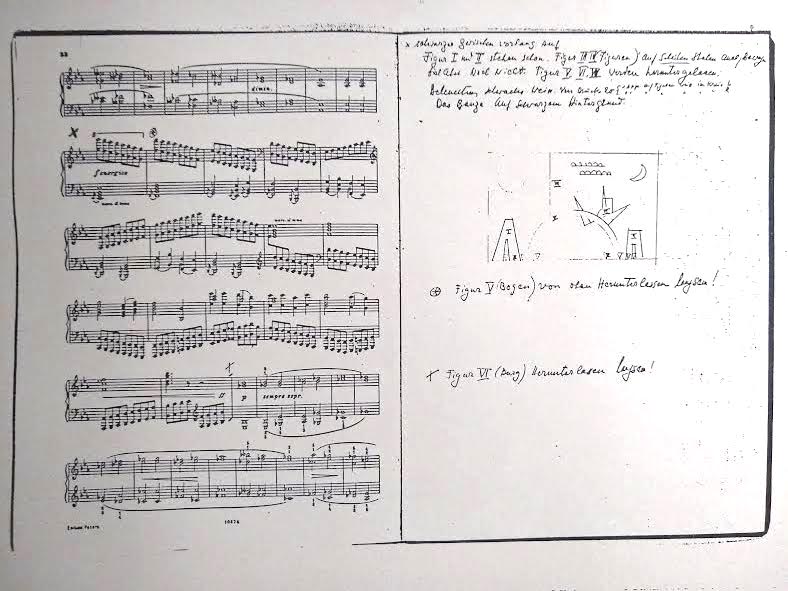|
What follows is the second part of one variant of a lecture I have given in many countries—to theatre professionals and conservatory students, theatre historians, theatre critics, and more. Versions have also been published in Korean and Chinese.
Last month's Introduction and Part 1 of 3 are here.
Part 2: The Plays
First Notes in German for "Black and White," 1908-9
Here is a quick overview: Kandinsky mainly completed three short plays between 1908 and 1909: "Green Sound," "Black and White," and "Black Figure." At the same time, he began the full-length play, "Yellow Sound," which he finished and published in Munich in 1912. In 1914, he wrote his longest play (and my favorite), "Violet," and what might be an after-piece for it, "Apotheosis." A portion of "Violet" was published in 1927 at the Bauhaus School of Architecture and Design, where he was famously working. The next year, in Dessau, he created a scenic play of sets, props and lights for Mussorgsky's "Pictures at an Exhibition."
Of these plays, people tend to find "Yellow Sound" the most approachable, maybe because it was published along with Kandinsky's essay, "On Stage Composition." There, he explained how he had tried to apply his theories of synthesis and counterpoint in "Yellow Sound." He was not quite sure it had worked. His final words before the pages of the play text began were: "The reader is asked not to ascribe to the principle the weaknesses of the following short composition, "Yellow Sound," but to attribute them to the author." In other words, if the play was weak, it was because his skills as a playwright hadn't served his theories of the stage.
The mood and look of "Yellow Sound" are easier to communicate than their stories: they have no literary value at all. They seem to take place outside of time, in a world where the environment is at least as active as the figures who live in it. The music and sounds that emanate from the space seem to be in dialogue with hills or trees; light moves, changes color, or darkens in reaction to simple gestures. Flowers shudder as if they were human, and people grow as if they were plants. The real protagonists of these plays are the stage elements that usually support the action, and the "characters" are only a part of what one scholar called "a cosmic melodrama."
The role the gods play in Greek drama is played in "Yellow Sound" by Nature; but like the gods', the natural world is more forceful than logical. Kandinsky's choruses are similar to some Greek choruses: crowds of barely differentiated figures, dimly grasping at comprehension, perhaps half a step behind the truth. Unlike the classical hero, Kandinsky's heroes achieve stature mainly due to their calm in the face of fear, confusion and loss. Aristotle's narrative drama attempted to explain the peaks and valleys we experience in our lives. Kandinsky's synthesizing drama attempted to reveal an inner landscape where everything is an event, nothing can be explained and the real story takes place in some intuitive dimension, invisibly.
"Violet," Tableau II, 1914.
See translated fragments of "Violet" Tableaus I, III, VI, and VII here
Like music, these plays don't tell a story, but they have meaning. Like painting, their form is not linear, but they have structure. Like dance, each piece has statement, development and closure. Like architecture, the plays depend on tensions and counter-tensions. Like sculpture, the plays give shape to volumes in space, and with poetry they share the element of sound in time.
Kandinsky's "Yellow Sound" was a victim of political instabilities and was never staged. It was planned for production in Munich in 1914, in Berlin in 1922 and then at the Bauhaus in 1927. Ten years after this last attempt, Kandinsky wrote wistfully in a letter: "But once again it didn't work out… Such things have their own destinies." But in a New York lecture in 1950, after Kandinsky's death and nearly forty years after he wrote "Yellow Sound," the composer Thomas von Hartmann still called "Yellow Sound" "the greatest venture of stage art to this day."
"Pictures at an Exhibition," Tableau XVI, (The Great Gate of Kiev), 1928

A page from Kandinsky's prompt script for "Pictures at an Exhibition," Tableau XVI. Production staged in 1928 at Dessau's Friedrich Theatre. At left, Mussorgsky's sheet music for the tableau; at right, Kandinsky's rehearsal notes, recorded by hand by Felix Klee (son of Paul Klee).
|